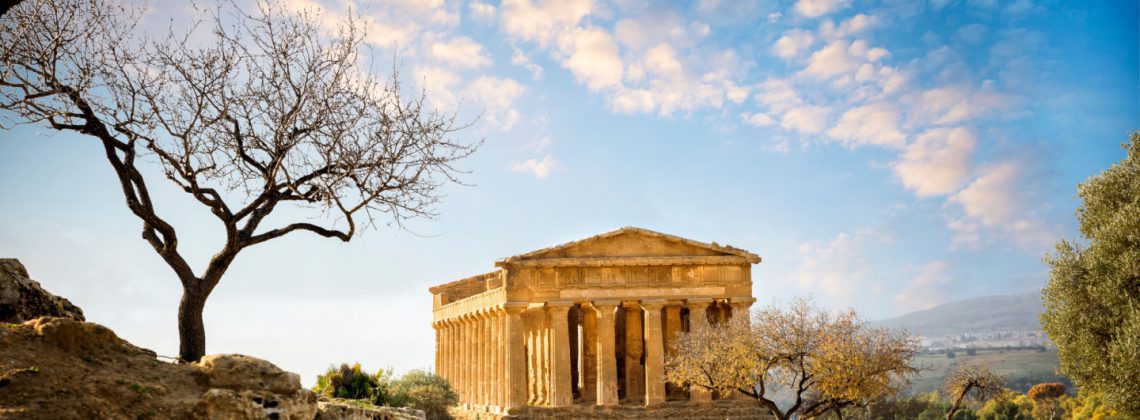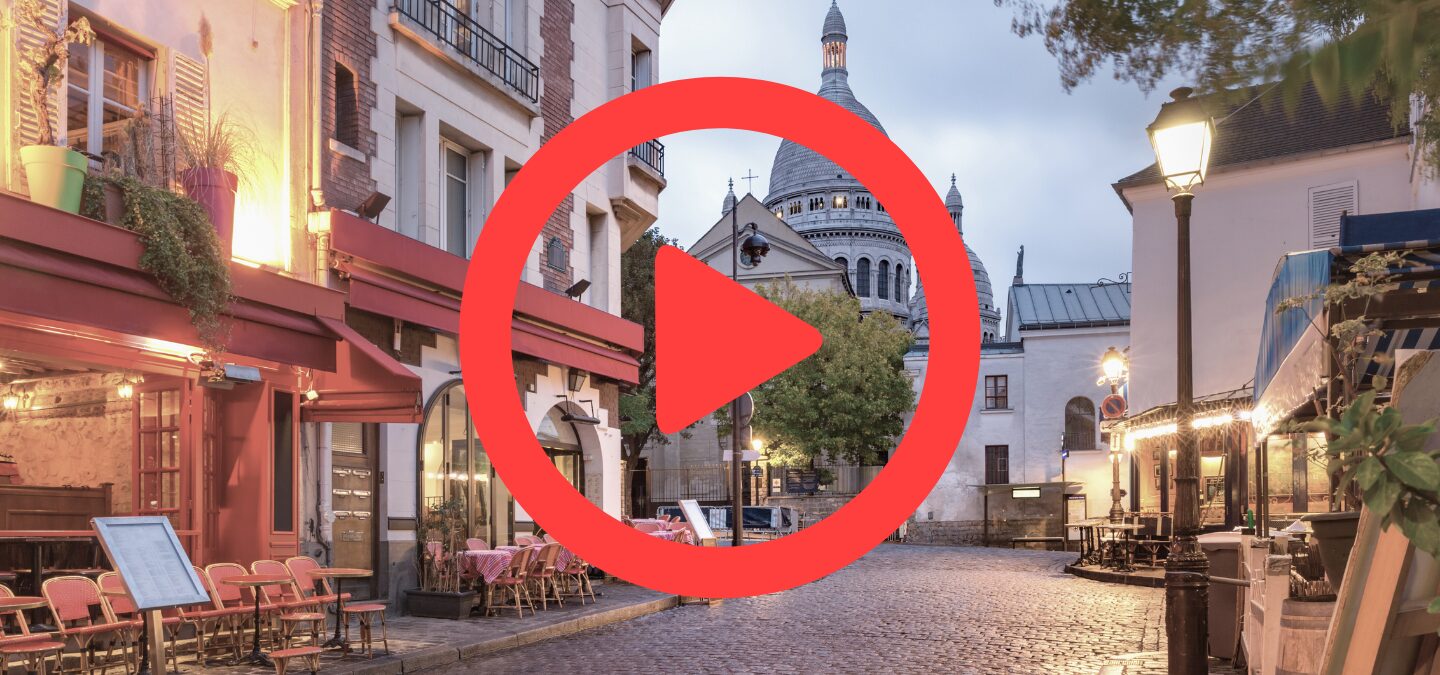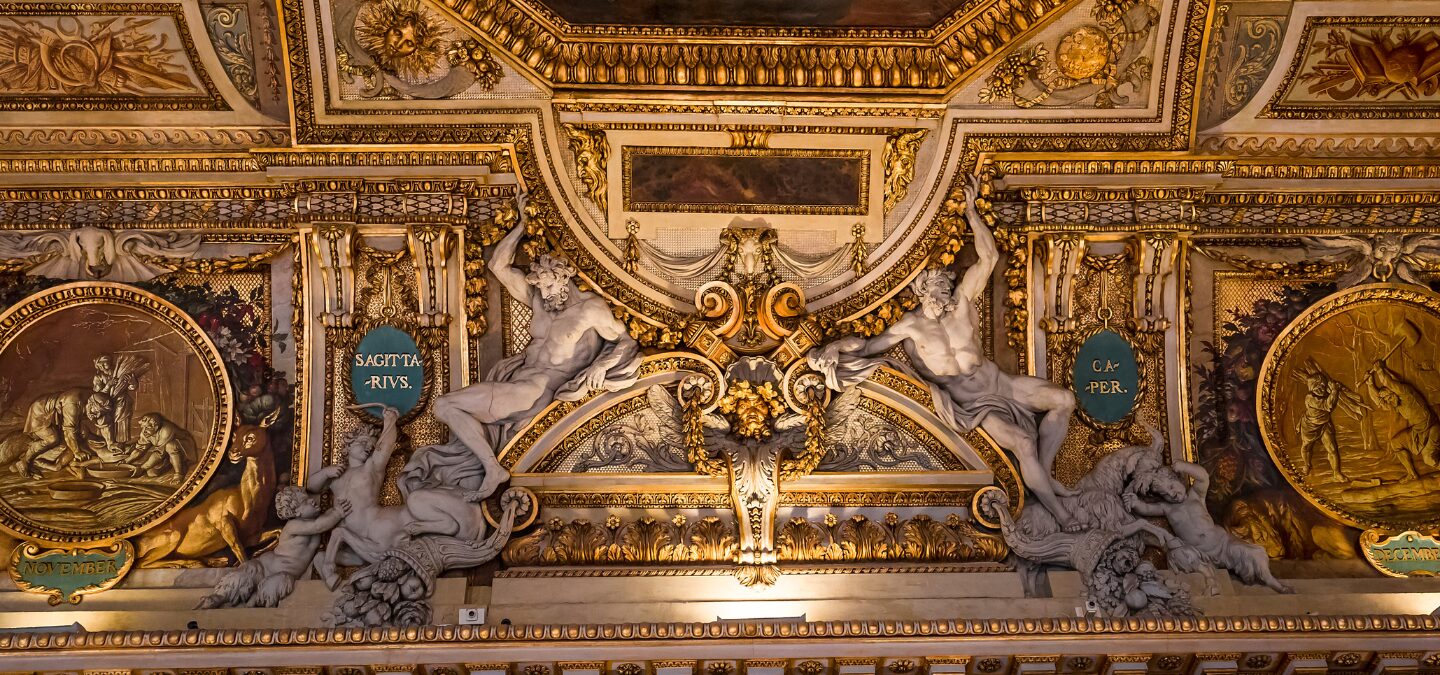Planning a trip to Sicily? Then a trip to Agrigento should be on any multiday itinerary. One of the largest archaeological areas in the world, Agrigento is one of the wonders of Sicily. With ten years of experience as a tour guide in Rome as well as four years working on archaeological sites across Italy, I’m here to guide you through the top things to see in Agrigento.
Pro Tip: You’re going to want to circle back to this article since it’s packed with local recommendations. Bookmark it in your browser on your phone so you’ll have it on your trip. Check out our full guide on where to stay in Sicily as well as the top things to do in Sicily.
A Very Brief History of Agrigento
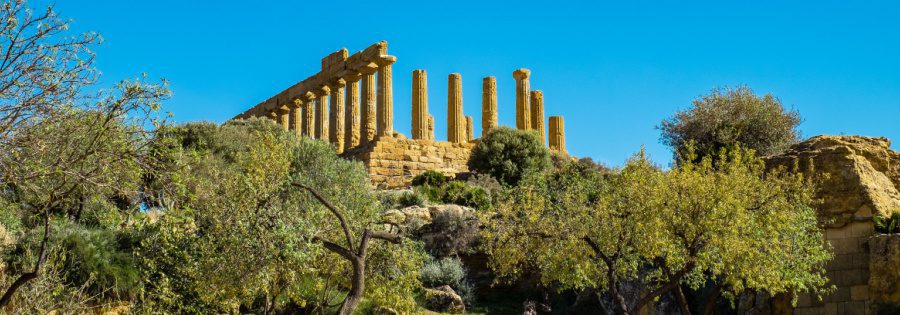
To the Greeks, she was Akraga. To the Romans, Agrigentum; and to us, Agrigento. Legend says the city was founded by Daedalus, the great Greek architect of King Minos’ labyrinth and builder of his son Icarus’s wax wings.
History, however, puts the city’s foundation down as 580 BC. In 406 BC, it was captured by the Carthaginians, who burnt the city and sold its inhabitants into slavery. It was taken by the Romans in 261 BC and remained part of the Roman Empire until its fall.
Sicily, for the Greeks, was the land of opportunity. When times were tough in Greece, fathers would tell their sons to head West to the land of plenty, to the land of perpetual spring. Akraga, at one point, was possibly the third-largest Greek city. The ancient historian Diodorus Siculus (1st century BC) claimed that it had 200,000 inhabitants. This is preposterous and not backed up by any archaeological evidence. Archaeologists ( a much more sensible bunch) put estimates at 15,000 to 20,000.
What is not in doubt is Agrigento’s cultural significance. Five beautifully preserved Doric Temples still stand, as well as a whole host of Greek and Roman ruins.
You can find our guide on what to see in Agrigento below.
- A Very Brief History of Agrigento
- The Top Things to See in Agrigento
- 1. The Temple of Hera
- 2. Via Sacra and The Walls of Akragas
- 3. Fallen Icarus
- 4. The Temple of Concordia
- 5. Paleochristian Necropolis
- 6. Villa Aurea
- 7. Temple of Herakles
- 8. The Temple of Olympian Zeus
- 9. The Telamons of the Temple of Zeus
- 10. Sanctuary of the Chthonic Divinities
- 11. Garden of Kolymbethra
- 12. The Roman and Hellenistic Quarter
- 13. San Biagio (Demeter)
- Where To Stay in Sicily
- Most Recent Blog Posts
The Top Things to See in Agrigento
A Note on Temple Names: The temples in Agrigento are often labeled differently. In some publications, the divinity is Greek, and in others Roman. For the sake of uniformity, I have gone with the Greek names since they were first built by the Greeks.
1. The Temple of Hera
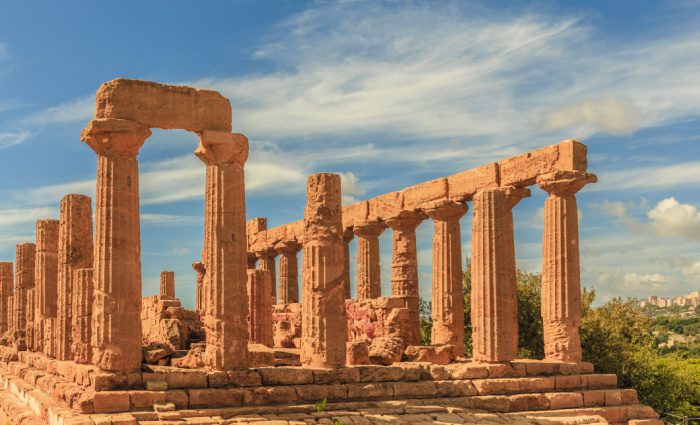
I’m going to let you in on a trade secret. When the description for an archaeological monument states ‘for ceremonial purposes’ or something similar, it often translates into common English as ‘we have no idea what this is for.’ However, that is not the case for the Temple of Hera. We know that this is a temple. But a temple dedicated to Hera? That’s more dubious. Most of the temples in Agrigento have names given through convention rather than any factual attribute.
What we do know is it was constructed between 450 BC and 440 BC.
The remains of the temple exhibit evidence of fire damage, which is believed to have been caused by the Carthaginian sacking in 406 BC. To the East, you’ll find a sacrificial altar, and on the West, you’ll find an ancient cistern.
2. Via Sacra and The Walls of Akragas
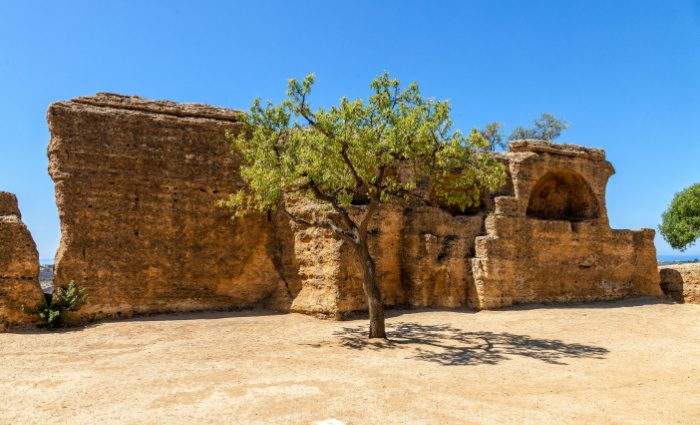
As you traverse the Via Sacra, you will find yourself engulfed on either side by ancient olive trees and almond groves (March is my favorite time in Agrigento because the almond trees are in full bloom).
As you make your way from the Temple of Hera to the Temple of Concord, keep your eyes to the left of the road, and you’ll find structural elements of the original city walls. They initially stretched 12km, following the natural contours of the countryside.
You’ll notice semi-circular niches cut into the walls, these are arcosolium. Arcosolia were used as tombs, often carved directly into the stone; a sarcophagus was then placed inside and sealed up.
3. Fallen Icarus
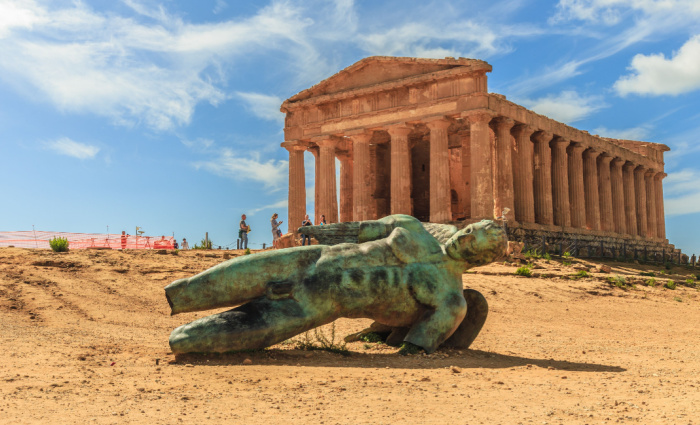
Polish artist Igor Mitoraj scattered seventeen bronze statues around Agrigento, with the statue of the ‘Fallen Icarus’ being the most famous or, at least, my favorite. According to legend, Icarus’s father, Daedalus, founded the city of Agrigento, making it a perfect subject for the area.
He sits, broken and discarded, in front of the Temple of Concordia.
4. The Temple of Concordia

The Temple of Concordia, apart from the temple of Hephaistos in Athens, likely stands as the best-preserved Greek temple. Constructed around 450-430 BC, its name comes from a Latin inscription found nearby that probably has no relevance to the temple itself.
Local tradition dictates that if a newlywed couple desires a stress-free life, they should visit the temple on their wedding day.
The temple consists of thirty-six outer Doric columns and four inner columns, each 6.8m high, each with twenty grooves. The temple sits on a solid base to offset the uneven ground, with a crepidoma of three steps.
The incredible level of preservation can be attributed to the fact that Saint Greogroy of the Turnips (the best saint name ever) converted it into a Christian church in the 6th century AD.
The Prince of Torremuzza, a Palermo aristocrat, turned it back into a temple in 1788.
5. Paleochristian Necropolis
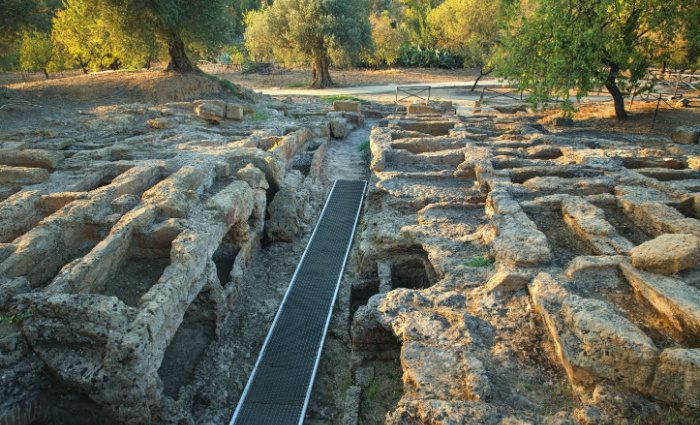
On your right, as you walk from the Temple of Concordia to the Temple of Herakles, you’ll find an early Christian burial ground. The shallow graves here date from the third to the sixth century AD. They show the transition of Agrigento from Greek and Roman theology to an early Christian settlement.
6. Villa Aurea
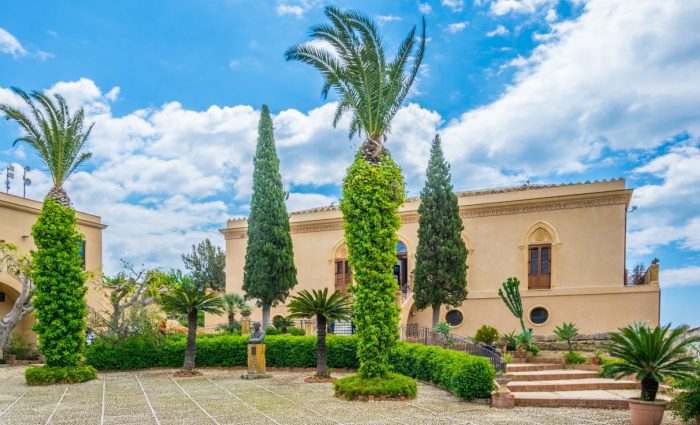
In the middle of all the ruins sticking out like a sore thumb, you’ll find the home of Captain Alexander Hardcastle. The eccentric Englishmen arrived in Agrigento in 1921 and repaired the villa. An incredibly wealthy man and a keen amateur archaeologist, he was a key figure in the restoration and excavation of Agrigento.
Hardcastle was declared bankrupt after the Wall Street crash of 1929. The economic situation made it impossible for him to sell the property, he quickly lost his mind and was eventually committed to the local mental asylum, where he died in 1933 at the age of 60.
7. Temple of Herakles
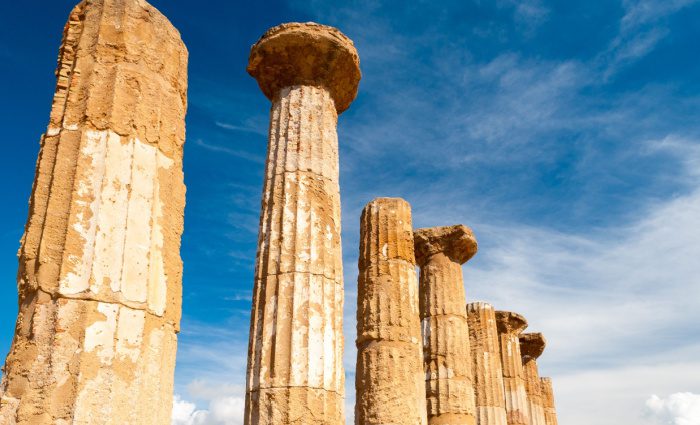
Built around 510 BC in the archaic Doric style, the Temple of Herakles is one of the oldest in Agrigento. The excessive fluting of the columns at the top and the number (fifteen on the side, six on the front, rather than the later thirteen on the side and six on the front) firmly place this as an archaic Doric temple.
The attribution of the name Herakles to the temple comes from Cicero’s ‘Verrine Orations’ (II:4.43). Caius Verres was the governer of Sicily who notoriously levied his power to steal some of the most outstanding artworks of antiquity, even stealing the famous statue of Herakles (completed by Myron, one of the ancient world’s most celebrated artists).
The people of Sicily hired Cicero to make their case and bring Verres to justice. The case launched Cicero’s career, and his speeches still exist to this day. The authorities never recovered the stolen art. Choosing self-exile over more stringent punishment, Verres lived out the rest of his days in Marseille.
8. The Temple of Olympian Zeus
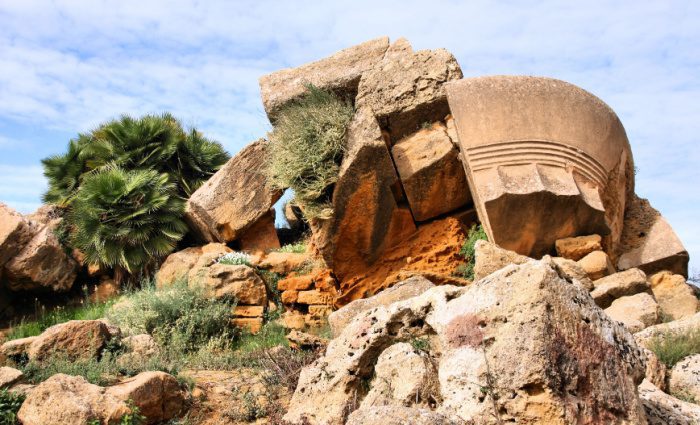
Potentially the largest Doric temple ever constructed in the Western world. I say potentially because estimates of its size vary due to the ruined nature of the temple. Used as a quarry in the 1800s, only fragments (though colossal in nature) of the temple survive.
What does survive is the base of the sacrificial altar of Olympian Zeus. The altar was constructed around 480 BC; sacrifices would take place at sunrise and would generally be of sheep or cattle.
Around the altar, you can still see scattered ruins of the columns and their capitols that help give an understanding of the scale of this magnificent structure.
9. The Telamons of the Temple of Zeus
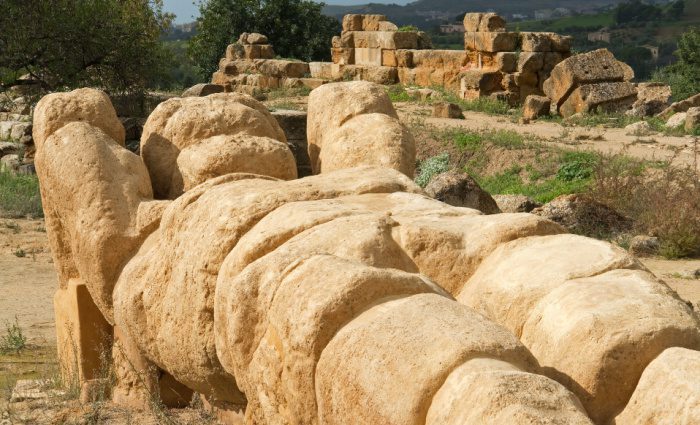
A telamon is a male figure used as a pillar to support a structure. The Telamons of the Temple of Olympian Zeus were giant figures. Standing eight meters tall, according to legend, they represent the defeated Carthigians beaten at Himera in 480 BC, their humiliation recorded in stone, imprisoned and holding up the roof of the victorious Zeus for all eternity.
10. Sanctuary of the Chthonic Divinities
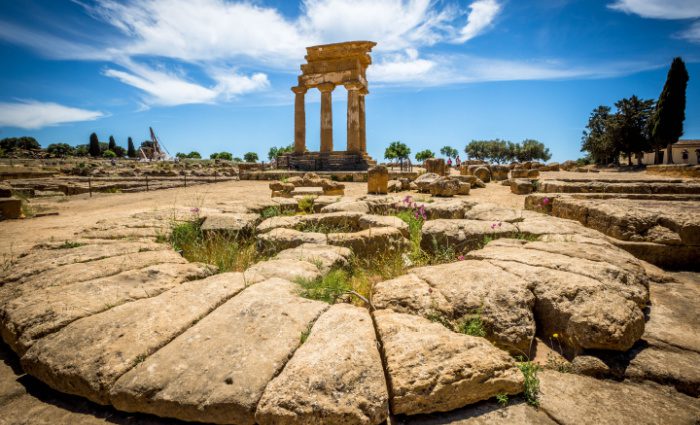
The Chthonic divinities (try saying that five times, quickly, after a couple of glasses of wine at lunch) were gods of the earth rather than those who sat haughtily on Mount Olympus.
Sicily had strong ties with these gods within the Greek Myths. According to legend, Demeter (the mother-earth goddess) gave the inhabitants of Sicily the gift of seeds, being the first to receive it. With the help of her daughter, Persephone, they became the first to cultivate it.
Two altars sit in the middle, one circular and one square, both date possibly as far back as the 7th century BC. Two unfinished temples (probably dating to the 6th Century) stand beside them, incorrectly (again) attributed to Castor and Pollux.
The Chthonic sanctuary was likely an area of communal sacrifice where the population came together to celebrate significant milestones each year, like the harvest festival. The sanctuary is one of the oldest sections of the entire archaeological complex.
11. Garden of Kolymbethra
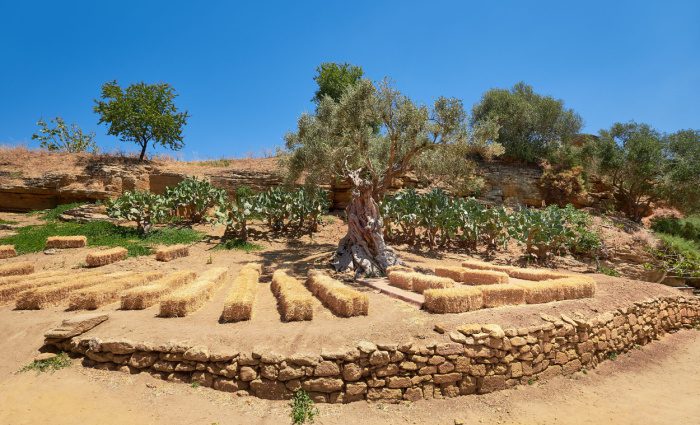
Theron, the Tyrant of Akragas (Agrigento), defeated the Carthaginians in a great battle outside the walls of nearby Himera in 480 BC. With the spoils and prisoners of war, he commissioned the building of a great freshwater lake (a Kolymbethra in Greek). The pond fell out of use less than a century later, probably due to waterborne diseases being prolific due to lack of maintenance.
The area became highly fertile. Olive trees planted litter the area as they did in the Greek and Roman age. In later centuries, the Arabs added Orange groves. The Italian conservation agency is today in charge of the garden’s upkeep.
12. The Roman and Hellenistic Quarter
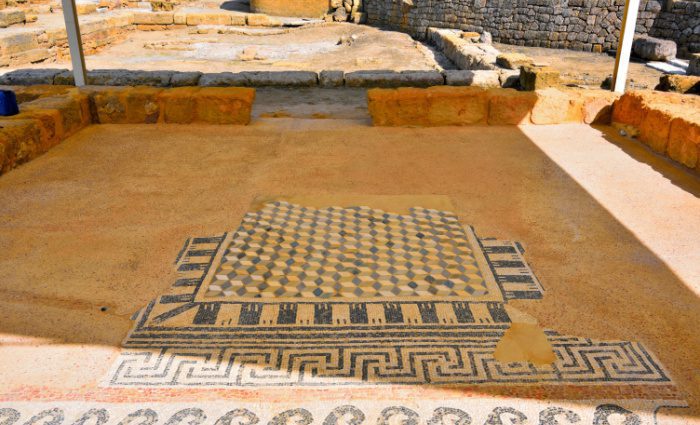
To the East of the main archaeological site, you’ll find the complex remains of the Hellenistic and Roman district. This area was first developed as the residential quarter in the 6th century BC before going through numerous regenerations, it fell into disuse around the 4th or 5th century AD. There are fantastic atrium houses with wonderful examples of Roman mosaics. Staircases can still be seen in a number of places, indicating some properties were multiple stories high.
13. San Biagio (Demeter)
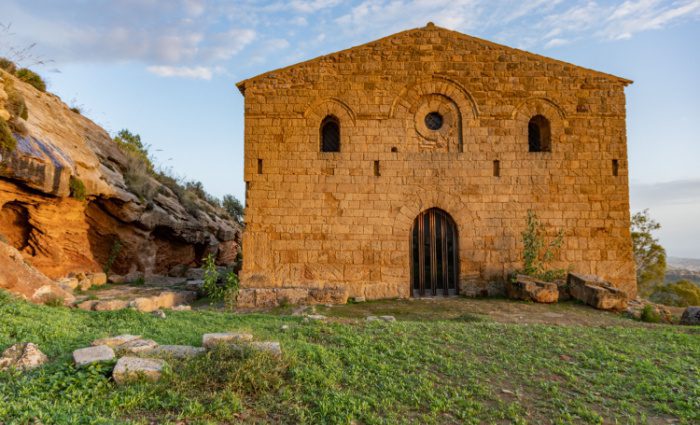
Outside of the main archaeological area, the Norman Church of San Biagio is built directly over the ruins of a 5th-century BC temple. It’s believed the temple was dedicated to Demeter. At the rear of the church, you’ll find the foundation of the temple protruding. A rectangular altar and two circular altars. The circular altars contain a sacred well that locals would throw offerings down to seek the blessing of Demeter.
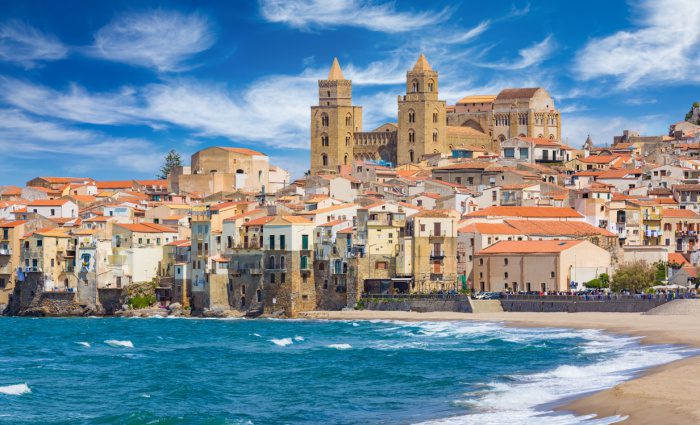
Where To Stay in Sicily
Sicily is one of Italy’s hottest destinations this year. Find our guide to the best places to stay in Sicily!
Most Recent Blog Posts
How to Plan a Trip to Paris – 2026 Video Guide
Stop stressing and watch this video guide to learn how to plan the perfect 2026 Paris trip.
Continue Reading How to Plan a Trip to Paris – 2026 Video Guide
Arezzo at Christmas: Inside Italy’s Biggest Christmas Market in Tuscany
Plan the perfect winter trip to Arezzo, Italy. Explore the Christmas market, historic sites, festive food, and easy travel tips from Florence or Rome.
Continue Reading Arezzo at Christmas: Inside Italy’s Biggest Christmas Market in Tuscany
The History of Christmas: From Ancient Rome to Santa Claus
Discover the real history of Christmas, from ancient Roman festivals to St. Nicholas, Sinterklaas, Santa Claus, and modern holiday traditions.
Continue Reading The History of Christmas: From Ancient Rome to Santa Claus
Europe Travel FAQs: Everything First-Time Travelers Need to Know Before Visiting
Planning your first trip to Europe? We’ve answered the most common questions about planning, transportation, tipping, scams, and more!
Continue Reading Europe Travel FAQs: Everything First-Time Travelers Need to Know Before Visiting
Spooky Sightseeing: Top Ghost Stories in History and Where to Find Them
Explore the spookiest and most fascinating ghost stories from history’s most notorious figures, from Marie Antoinette to Nero and beyond.
Continue Reading Spooky Sightseeing: Top Ghost Stories in History and Where to Find Them
The Louvre Heist: What Was Taken & Why Does It Matter?
A daring daylight heist at the Louvre left Paris stunned as thieves stole priceless Napoleonic jewels in minutes. Here’s how it all unfolded.
Continue Reading The Louvre Heist: What Was Taken & Why Does It Matter?
